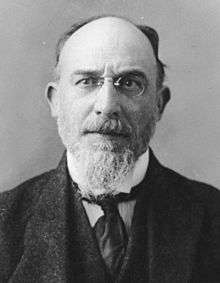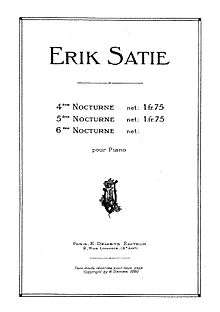Nocturnes (Satie)
The Nocturnes are five piano pieces (planned as a set of seven, but unfinished) [1] by Erik Satie. They were written between August and November 1919. With the exception of the Premier Menuet (1920) they were his final works for solo piano, and are considered among his most significant achievements in the genre.[2][3] The Nocturnes stand apart from Satie's piano music of the 1910s in their complete seriousness, lacking the zany titles, musical parody, and extramusical texts he typically featured in his scores of the time. In performance the set lasts about 13 minutes.

Background
Much had transpired in Satie's personal and professional lives in the two years since his previous keyboard piece, the Neoclassical spoof Sonatine bureaucratique (1917). There was the fallout from the scandalous premiere of his ballet Parade (1917),[4] including Satie's conviction of criminal libel for sending insulting postcards to a critic, from which he narrowly escaped imprisonment; his bitter estrangement from longtime friend Claude Debussy, and Debussy's subsequent death; and completion of the work he believed represented the best of himself, the "symphonic drama" Socrate (1918). Ridiculed by the French press and dogged by chronic poverty, Satie fell into a depressed state that reached its nadir in August 1918, when he wrote to Valentine Hugo, "I shit on Art, it has 'cut me up' too often." [5] He then proceeded to break with the Nouveaux jeunes group of musicians he had recently founded, an act that set the stage for their eventual regrouping as Les Six. By the summer of 1919 his creative energies had revived, though his spirits remained hard-bitten and gloomy. "I have changed a lot during these last months", he mused to singer Paulette Darty. "I am becoming very serious...too serious, even." [6] Such feelings may have steered him to the nocturne form itself - the province of Chopin,[7] evocative of the night and usually quiet and introspective - and affected the way the project developed.
Composition
Satie's notebooks reveal he initially intended to present the Nocturnes with the whimsical literary humor the Parisian public had come to expect from him. The first piece had the working title Faux Nocturne and was accompanied by one of those little stories he seemed to enjoy writing for the pianist's private amusement:[8]
The night is silent
Melancholy is all-pervasive
The will-o'-the-wisp disturbs the peaceful landscape
What a bore! It's an old will-o'-the-wisp
Trust him to come
Let us resume our reverie, if you will [9]
But he soon abandoned the text and satirical nomenclature, choosing instead to let the Nocturnes stand as pure music. He also wrote them using conventional bar lines, a practice he had largely eschewed in piano music for nearly 30 years before returning to it – perhaps with a dash of irony – in the Sonatine bureaucratique.
On August 24, 1919, Satie informed Valentine Hugo: "I am coming to the end of my Third Nocturne. I am dedicating it to you. The three of them are not at all bad. The first serves as a prelude; the second is shorter and very tender – very nocturnal; the third, yours, is a more rapid and dramatic nocturne, a little longer than the first. Between the three of them they form a whole with which I am very pleased – though the first is the least good."[10] This assessment was premature. Satie was not satisfied with the second Nocturne until the following month, and he continued to tinker with No. 3 until October - by which time he was developing ideas for additional pieces in the series. Nos. 4 and 5 are dated October and November 1919, respectively.
Publication and performance

Printing of the Nocturnes was split between two of Satie's regular publishers. Rouart, Lerolle & Cie issued Nos. 1–3 in late 1919; Nos. 4 and 5 were brought out by the firm E. Demets in 1920. Demets also advertised a sixth Nocturne without a price,[11] indicating it was a work in progress, but the piece would not appear in the composer's lifetime.
Satie dedicated each of the completed five to a patron or proponent of his music:
- 1. Doux et calme (Soft and Quiet), for Marcelle Meyer
- 2. Simplement (Simply), for André Salomon[12]
- 3. Un peu mouvementé (Somewhat Eventful), for Valentine Hugo
- 4.

- 5.

The Nocturne No. 1 was premiered by Jane Mortier at the Salle Pleyel in Paris on March 18, 1920; Nos. 1–3 were performed by Ricardo Viñes during an all-Satie concert at the Salle Érard on June 7, 1920. The fourth Nocturne was not heard until January 4, 1923, when it was played by Jean Wiener at the Théâtre des Champs-Élysées. There is no clear indication of the debut for No. 5; Marcelle Meyer may have performed it in 1921.[15]
Reception
The Nocturnes caused no immediate stir, although at the Viñes performance Jean Cocteau and Les Six members Darius Milhaud and Louis Durey expressed their enthusiasm.[16] Given Satie's reputation as a musical humorist, the audience may have been unsure if it was having its leg pulled.[17] But they have long been prized by Satie aficionados. John Cage championed them in the United States after World War II, and they inspired choreographer Merce Cunningham's ballet Nocturnes (1956), in which the dances were created using chance procedure.[18] Rollo H. Myers, Satie's first biographer in English (1948), ranked the Nocturnes with a handful of Satie compositions that are "outstanding and cannot be ignored by any student of contemporary music." He continued: "The Nocturnes are in a sense the natural corollary of Socrate, which preceded them by a year, and are conceived in the same gravely austere mood. The style is chastened, simplified, uncompromising in its rejection of any sensuous appeal, but the music is strangely impressive in its bleakness and almost inhuman detachment."[19] The Nocturnes have never enjoyed the mainstream popularity of the Gymnopédies or other Satie piano works, and while they have been recorded by such artists as Aldo Ciccolini, Pascal Rogé and Jean-Yves Thibaudet, they remain, according to John Keillor's AllMusic review, "among the undiscovered masterpieces of the twentieth century."[20]
Posthumous Nocturnes
Shortly before his death in 1925, Satie told Robert Caby that the manuscript of his sixth Nocturne was virtually complete and might be published someday.[21] Six decades later, musicologist Robert Orledge examined Satie's notebooks from the period and discovered a single full draft of a piano piece, missing only two bars of the left-hand part.[22] Orledge completed a performing version and it was published as Satie's Nocturne No. 6 in 1994. Speculative versions of a Nocturne No. 7, based on a 12-bar sketch in the notebooks,[23] have been created by Orledge and others.
Recordings
Aldo Ciccolini recorded Nos. 1-3 for EMI in 1968, Nos. 4 and 5 in 1971, and 1–5 in 1988. Other notable recordings are by Frank Glazer (Vox, 1968), Jean-Joël Barbier (Universal Classics France, 1971, reissued 2002), Yūji Takahashi (Denon, 1976), Daniel Varsano (Columbia, 1979, reissued by Sony Classics 1992), France Clidat (Forlane, 1984), Klára Koermendi (Naxos, 1993), Bojan Gorišek (Audiophile Classics, 1994), Pascal Rogé (London, 1996), Olof Höjer (Swedish Society Discofil, 1996), Jean-Yves Thibaudet (Decca, 2002), and Cristina Ariagno (Brilliant Classics, 2006).
Notes and references
- Satie planned to write at least seven Nocturnes, with No. 4 serving as an "interlude" between two sets of three, based on material in the composer's notebooks at the Bibliothèque nationale de France, Paris. See Robert Orledge, "Satie the Composer", Cambridge University Press, 1990, pp. 194–195 and p. 318.
- Rollo H. Myers, "Erik Satie", Dover Publications, Inc., NY, 1968, p. 58. Originally published in 1948 by Denis Dobson Ltd., London.
- Patrick Gowers and Nigel Wilkins, "Erik Satie", "The New Grove: Twentieth-Century French Masters", Macmillan Publishers Limited, London, 1986, p. 142. Reprinted from "The New Grove Dictionary of Music and Musicians", 1980 edition.
- "Parade has separated me from a great many friends. This work is the cause of many misfortunes." Erik Satie, letter to Henry Prunières dated September 14, 1917. Quoted in Ornella Volta (ed.), "Satie Seen Through His Letters", Marion Boyars Publishers, London, 1989, p. 149.
- Letter to Valentine Hugo, August 23, 1918. Ornella Volta (ed.), "Erik Satie: Correspondance presque complete", Fayard, Paris, 2003.
- Erik Satie, letter to Paulette Darty dated November 22, 1919, around the time he completed the 5th Nocturne. Quoted in Orledge, "Satie the Composer", p. 356.
- Satie greatly admired Chopin, referring to him as a "poet" and "prodigious creator" in his journalistic writings (e.g., his 1922 Vanity Fair article on Stravinsky). Rollo H. Myers, for one, found "Chopinesque" qualities in the 4th Nocturne (Myers, "Erik Satie", p. 92). Satie would also have known the Nocturnes of another Chopin fan, Debussy.
- Satie manuscript, BNF 9609 (2) pp. 2–6, Bibliothèque nationale de France. See Robert Orledge, "Appendix: Chronological Catalogue of Satie's Compositions and Research Guide to the Manuscripts", published in Dr. Caroline Potter (ed.), "Erik Satie: Music, Art and Literature", Ashgate Publishing, LTD, 2013, pp. 243-324.
- Quoted in Olof Höjer's notes to "Erik Satie: The Complete Piano Music, Vol. 6", Swedish Society Discofil, 1996.
- http://thefrogweb.wordpress.com/2010/04/18/satie1/ Quoted by Robert Orledge in "Erik Satie - Six Nocturnes - and a trio of Sevens", part of the article "Erik Satie: Autour des Nocturnes" posted on The Frogweb April 18, 2010.
- http://imslp.org/wiki/File:SIBLEY1802.20119.78d4-39087012833523score.pdf
- André Salomon (1881-1944) was a French-Jewish pianist and teacher associated with Satie's music of the World War I era, including performances of the musique d'ameublement ("furniture music"). He perished in the Nazi death camp at Auschwitz during World War II. See http://data.bnf.fr/15731335/andre_salomon/
- Edith de Beaumont (1877-1952), wife of Count Étienne de Beaumont, both of whom were among Satie's chief benefactors after World War I.
- Eugénie Cocteau (1855-1943), Jean Cocteau's mother.
- Orledge, Potter (ed.), "Erik Satie: Music, Art and Literature", pp. 243-324.
- Orledge, "Satie the Composer", p. 356.
- This same concert saw the premiere of Socrate in its version for chamber orchestra, and its second public performance overall. It overshadowed the Nocturnes, though for reasons the composer found unwelcome. Satie was exasperated by critics who, refusing to take him seriously, imagined that Socrate was the driest musical "joke" he ever perpetrated. See Steven Moore Whiting, "Satie the Bohemian: From Cabaret to Concert Hall", Oxford University Press, 1999, pp. 557–559.
- Merce Cunningham Trust website, page devoted to the Nocturnes ballet, http://www.mercecunningham.org.
- Myers, "Erik Satie", p. 92.
- http://www.allmusic.com/composition/nocturnes-5-for-piano-mc0002361883 John Keillor Allmusic review.
- Orledge, Potter (ed.), "Erik Satie: Music, Art and Literature", pp. 243–324.
- Satie manuscript, BNF 9609 (2) pp. 15–18, Bibliothèque nationale de France. Orledge, Potter (ed.), "Erik Satie: Music, Art and Literature", pp. 243–324.
- Satie manuscript, BNF 9609 (4) pp. 6–8, Bibliothèque nationale de France. Orledge, Potter (ed.), "Erik Satie: Music, Art and Literature", pp. 243-324.